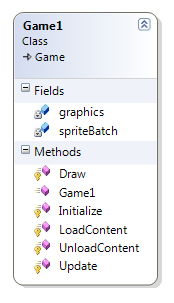Difference between revisions of "Monogame Overview"
(→Basic XNA Game Structure) |
|||
| Line 5: | Line 5: | ||
[http://msdn.microsoft.com/en-us/library/ff827897.aspx Introduction to XNA Game Studio 4.0] | [http://msdn.microsoft.com/en-us/library/ff827897.aspx Introduction to XNA Game Studio 4.0] | ||
| − | ==Basic | + | ==Basic Monogame Game Structure== |
[[Image:XNAGame1UML.PNG]] | [[Image:XNAGame1UML.PNG]] | ||
{{Template:XNA_structure}} | {{Template:XNA_structure}} | ||
Latest revision as of 15:01, 28 July 2016
Contents
Why Monogame?
DirectX is Hard.
Introduction to XNA Game Studio 4.0
Basic Monogame Game Structure
The Game class in XNA has many default methods tha tare used to help define a structure for the game. Most XNA Game Components will inherit from this class
Game Methods
- XNA's base class.
Constructor()
- Instantiates objects from classes. New instances of a class are created with the keyword new.
Initialize()
- Initializes all variables. Assigns static variables a value.
LoadGraphicsContent()
- Loads code and images to the memory of the graphics card.
UnloadGraphicsContent()
- Clear the memory of the graphics card.
Game loop
Update()
- Updates game logic – Move, input, score, network, sound. Guarenteed to be called on every iteration
Draw()
- Draws to the screen - May not be called every loop. Should be short and exit quickly
Default Game Class
#region Using Statements
using System;
using System.Collections.Generic;
using Microsoft.Xna.Framework;
using Microsoft.Xna.Framework.Audio;
using Microsoft.Xna.Framework.Content;
using Microsoft.Xna.Framework.Graphics;
using Microsoft.Xna.Framework.Input;
using Microsoft.Xna.Framework.Storage;
#endregion
namespace WindowsGameDemo
{
/// <summary>
/// This is the main type for your game
/// </summary>
public class Game1 : Microsoft.Xna.Framework.Game
{
GraphicsDeviceManager graphics;
ContentManager content;
public Game1()
{
graphics = new GraphicsDeviceManager(this);
content = new ContentManager(Services);
}
/// <summary>
/// Allows the game to perform any initialization it needs to before starting to run.
/// This is where it can query for any required services and load any non-graphic
/// related content. Calling base.Initialize will enumerate through any components
/// and initialize them as well.
/// </summary>
protected override void Initialize()
{
// TODO: Add your initialization logic here
base.Initialize();
}
/// <summary>
/// Load your graphics content. If loadAllContent is true, you should
/// load content from both ResourceManagementMode pools. Otherwise, just
/// load ResourceManagementMode.Manual content.
/// </summary>
/// <param name="loadAllContent">Which type of content to load.</param>
protected override void LoadGraphicsContent(bool loadAllContent)
{
if (loadAllContent)
{
// TODO: Load any ResourceManagementMode.Automatic content
}
// TODO: Load any ResourceManagementMode.Manual content
}
/// <summary>
/// Unload your graphics content. If unloadAllContent is true, you should
/// unload content from both ResourceManagementMode pools. Otherwise, just
/// unload ResourceManagementMode.Manual content. Manual content will get
/// Disposed by the GraphicsDevice during a Reset.
/// </summary>
/// <param name="unloadAllContent">Which type of content to unload.</param>
protected override void UnloadGraphicsContent(bool unloadAllContent)
{
if (unloadAllContent)
{
// TODO: Unload any ResourceManagementMode.Automatic content
content.Unload();
}
// TODO: Unload any ResourceManagementMode.Manual content
}
/// <summary>
/// Allows the game to run logic such as updating the world,
/// checking for collisions, gathering input and playing audio.
/// </summary>
/// <param name="gameTime">Provides a snapshot of timing values.</param>
protected override void Update(GameTime gameTime)
{
// Allows the game to exit
if (GamePad.GetState(PlayerIndex.One).Buttons.Back == ButtonState.Pressed)
this.Exit();
// TODO: Add your update logic here
base.Update(gameTime);
}
/// <summary>
/// This is called when the game should draw itself.
/// </summary>
/// <param name="gameTime">Provides a snapshot of timing values.</param>
protected override void Draw(GameTime gameTime)
{
graphics.GraphicsDevice.Clear(Color.CornflowerBlue);
// TODO: Add your drawing code here
base.Draw(gameTime);
}
}
}
Hello Monogame with texture
Simple xna project that draws a pacman sprite
- Start a new Monogame Project
Add two variable declarations at the top of the class
Texture2D PacMan;
Vector2 PacManLoc;
In the LoadContent Function add the following code to initialize the two variables declared above
protected override void LoadContent()
{
// Create a new SpriteBatch, which can be used to draw textures.
spriteBatch = new SpriteBatch(GraphicsDevice);
// TODO: use this.Content to load your game content here
//load PacMan image
PacMan = Content.Load<texture2d>("pacmanSingle");
//Center PacMan image
PacManLoc = new Vector2(graphics.GraphicsDevice.Viewport.Width / 2, graphics.GraphicsDevice.Viewport.Height / 2);
}
- Add the following code to the Draw Method to Draw the texture
protected override void Draw(GameTime gameTime)
{
graphics.GraphicsDevice.Clear(Color.CornflowerBlue);
// TODO: Add your drawing code here
spriteBatch.Begin();
spriteBatch.Draw(PacMan, PacManLoc, Color.White);
spriteBatch.End();
base.Draw(gameTime);
}
pacman image is availble here: 
the full game1.cs file should look like
[http://brookfield.rice.iit.edu/jmeyers/gbrowser.php?file=/ITM496-595/ClassSource/Projects/IntroSimpleSpriteWindows/IntroSimpleSpriteWindows/Game1.cs IntroSimpleSpriteWindows/Game1.cs]
the build of the game will look like
![]()
Demo With SpriteFont
Let's add update
Simple 2D texture example with update
Lets Add two more members to the Game1 class
Vector2 PacManLoc, PacManDir; //Loaction and Direction for PacManfloat PacManSpeed; //speed for the PacMan Sprite
Then we'll add code to the update method
// TODO: Add your update logic here
//Elapsed time since last update
float time = (float)gameTime.ElapsedGameTime.TotalMilliseconds;
//Turn PacMan Around if it hits the edge of the screen
if ( (PacManLoc.X > graphics.GraphicsDevice.Viewport.Width - PacMan.Width)
|| (PacManLoc.X < 0 )
)
{
PacManDir = Vector2.Negate(PacManDir);
}
//Move PacMan
//Simple move Moves PacMac by PacManDiv on every update
//PacManLoc = PacManLoc + PacManDir;
//Time corrected move. MOves PacMan By PacManDiv every Second
PacManLoc = PacManLoc + ((PacManDir * PacManSpeed) * (time/1000)); //Simple Move PacMan by PacManDir
GameTime
FrameRate and GameTime
KeyBoard Demo?
